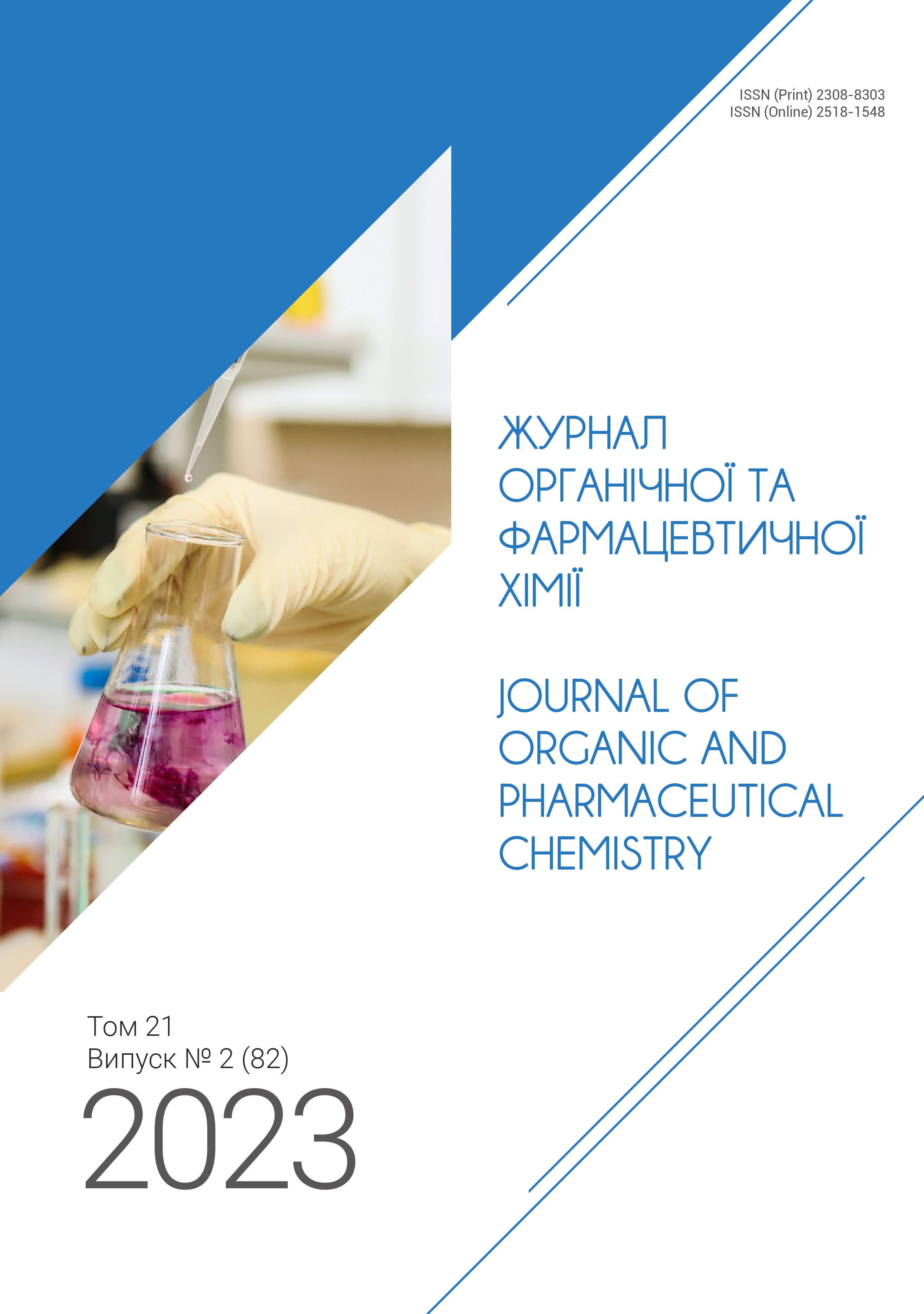Vol. 21 No. 2 (2023)
Advanced Researches
-
N-Silylimine of Trifluoropyruvate in the Asymmetric Synthesis of Trifluoroalanine Derivatives
Aim. To develop a preparative method for the synthesis of N-trimethylsilylimine of trifluoropyruvate, and study its interaction with acetone under organocatalytic conditions.
Results and discussion. A simple preparative approach to the first representative of N-silylimines of trifluoropyruvate was developed based on the interaction of triphenylphosphinimide and trifluoropyruvic acid methyl ester by the aza-Wittig reaction. It was found that the addition of acetone to N-silylimine occurred in the presence of L- or D-proline and led to the formation of enantiomerically enriched α-amino-γ-oxocarboxylates. The hydrolysis of the ester function resulted in (R)-α-trifluoromethyl aminocarboxylic acid, and the cyclocondensation with isocyanates or 2,5-dimethoxytetrahydrofuran yielded nitrogen-containing heterocycles containing pyrimidine or pyrrolizine nuclei.
Experimental part. The synthetic procedures for the N-silylimine of trifluoropyruvate and its reaction with acetone are provided, along with the transformations of obtained α-amino-γ-oxocarboxylates (hydrolysis, cyclocondensations with isocyanates and 2,5-dimethoxytetrahydrofuran). The structures of the compounds synthesized were proven by 1H, 13C, 19F NMR spectroscopy methods, as well as by the elemental analysis.
Conclusions. A convenient method for the synthesis of N-silylimine of trifluoropyruvate has been developed. Using the example of the Mannich reaction with acetone, it has been demonstrated that N-silylimine of trifluoropyruvate is a convenient substrate for the synthesis of optically active 3,3,3-trifluoroalanine derivatives.
Original Researches
-
The Synthesis and Acid-base Properties of α-(Fluoromethyl)- and α-(Difluoromethyl)-substituted Cyclobutane Building Blocks
Aim. To synthesize cyclobutane-derived amines and carboxylic acids bearing CH2F or CHF2 groups in the α position; to determine the regularities of the effect of fluoroalkyl substituents on the acid-base properties of the title compounds.
Results and discussion. Synthetic approaches to 1-(fluoromethyl)- and 1-(difluoromethyl)cyclobutanamines, 1-(fluoromethyl)- and 1-(difluoromethyl)cyclobutanecarboxylic acids have been developed. It has been found that the pKa (pKa(H)) values measured for the title compounds, as well as for their non-substituted and CF3-substituted analogues, are consistent with the electron-withdrawing effect of the corresponding fluoroalkyl substituents.
Experimental part. The synthesis of the title compounds commenced from the known ethyl 1-(hydroxymethyl)cyclobutanecarboxylate or the product of its Swern oxidation (the corresponding aldehyde) and included fluorination, alkaline ester hydrolysis (for carboxylic acids), and modified Curtius rearrangement (for amines). The pKa value was determined from the pre-equivalence point part of the titration curve using the standard acid-base titration.
Conclusions. A newly developed synthetic approach to 1-(fluoromethyl)- and 1-(difluoromethyl)cyclobutanamines, 1-(fluoromethyl)- and 1-(difluoromethyl)cyclobutanecarboxylic acids allows to obtain the title compounds in multigram quantities (up to 97 g). With a single exception, the acid-base properties of these products, as well as their parent non-substituted and CF3-substituted analogues, change in a monotonous manner in accordance with inductive electronic effect of the fluorine atom(s). -
The Synthesis of 1-Alkyl-3-polyfluoroalkyl- 1,3-dihydrobenzimidazole-2-selenones as Potential Plant Growth Regulators
Aim. To synthesize new 1-alkyl-3-polyfluoroalkyl-1,3-dihydrobenzimidazole-2-selenones and study their biological activity as potential plant growth regulators.
Results and discussion. 1-Alkyl-3-polyfluoroalkyl-1,3-dihydrobenzimidazole-2-selenones were obtained from the corresponding 1-alkyl-3-polyfluoroalkylbenzimidazolium iodides by the action of elemental selenium in the presence of a base. The preliminary biological tests for the growth-regulating activity of the compounds obtained were conducted.
Experimental part. The structure of the compounds synthesized was proven by 1H and 19F NMR spectroscopy methods, as well as by the elemental analysis. The biological studies were done on model plants of winter wheat of the “bezosta” variety.
Conclusions. A convenient method for obtaining 1-alkyl-3-polyfluoroalkyl-1,3-dihydro-benzimidazole-2-selenones has been developed. Biological studies have shown that the compounds synthesized have a diverse effect on the plant growth. -
The Quantitative Determination of Oxacillin Using Kinetiс-Spectrophotometric and Redox Titration Methods
The search for new analytical reactions and finding out the optimal conditions for their course, which can be used as the basis for quantitative analytical determinations of penicillins, is a very urgent task.
Aim. To develop methods for the quantitative determination of Oxacillin.
Materials and methods. The study object was Oxacillin sodium salt powder in vials for preparing a solution for injections
(0.5 g). Peroxomonosulfate acid as triple potassium salt 2КНSO5∙КНSO4∙K2SO4 (Oxone®) of “extra pure” grade was used as an oxidant. The methods of kinetic spectriphotometry and redox titration were used.
Results and discussion. A simple procedure for the quantitative determination of the Oxacillin pure substance by the kinetic spectrophotometry and redox titration methods using potassium hydrogen peroxomonosulfate (KHSO5) has been developed. The results of the drug analysis obtained by newly developed and current methods are in good agreement with each other; δ (correctness) = (0.45 – 0.86) %.
Conclusions. Using the methods of kinetic spectrophotometric and redox titration, two independent procedures for the
quantitative determination of oxacillin in the substance and the drug product have been developed using potassium hydrogen peroxomonosulfate as an analytical reagent (KHSO5). A relative standard deviation RSD = (1.24 – 2.17) %. -
Assessment of the Commercially Available Chemical Space for Using in the 19F NMR FAXS Method: a Enamine Ltd. Case
Aim. To analyze commercially available fluorine containing compounds for the possibility of their use in the 19F NMR FAXS method.
Materials and methods. The selection of fluorine-containing fragments for the study was performed using 3.9 million instock screening compounds and 248,000 in-stock building-blocks from Enamine Ltd library. The selection and classification of the compounds was carried out using the DataWarrior and KNIME software. The Fluorinated Fragments library of Enamine Ltd. containing 6377 compounds, was also analyzed. To analyze the abovementioned sets of substances, the multistep workflows specially designed were used.
Results and discussion. As a result of applying the workflow developed to the compound sets (both screening compounds and building blocks), 13 800 compounds were selected and further classified according to the presence of one out of 12 fluorine-containing groups. The Fluorinated Fragments library was also subjected to a similar workflow. For the latter, 8 out of 12 fluorine-containing groups were identified. Additionally, experimental 19F NMR chemical shift values for Fluorinated Fragments library compounds spectra were analyzed. It has been found that some structural classes have areas of chemical shifts intersection. On the other hand, the ranges from –40 to –60 ppm and beyond –160 ppm are free from any group of compounds from the library analyzed.
Conclusions. The analysis has shown that commercially available fluorine-containing fragments do not satisfy the needs of the 19F NMR FAXS method, and further expansion of the chemical space of fluorine-containing compounds by increasing their diversity is required. -
Electrophilic Reactions of 7-(Trifluoromethyl)-2,3-dihydro- 1H-pyrrolizine: a Way Towards New Building Blocks
Aim. To synthesize new fluoro-containing building blocks for medicinal chemistry purposes using electrophilic reactions of 7-(trifluoromethyl)-2,3-dihydro-1H-pyrrolizine.
Results and discussion. Synthetic approaches to 5-halogeno- and 5-acyl-7-(trifluoromethyl)-2,3-dihydro-1H-pyrrolizines have been developed. The obtained new trifluoromethyl-containing pyrrolyzines are promising building blocks for medicinal chemistry.
Experimental part. The synthesis of the target compounds began with known 7-(trifluoromethyl)-2,3-dihydro-1H-pyrrolizine and included halogenation and acylation reactions using N-halogen succinimides and acylating reagents.
Conclusions. New synthetic approaches to a number of 7-(trifluoromethyl)-2,3-dihydro-1H-pyrrolizines with various substituents, such as halogen atoms or acyl groups, at the position 5 of the pyrrole ring have been developed. This opens the door to the use of such promising trifluoromethyl-containing building blocks for medicinal chemistry needs. -
Synthesis of Functionalized 4,5-Dihydroisoxazoles Decorated with the Dimethylphosphinoyl Group
Aim. To synthesize a hybrid molecular platform incorporating dimethylphosphinoyl and 4,5-dihydroisoxazole moieties suitable for the creation of focused combinatorial libraries of compounds.
Results and discussion. The base-promoted interaction of halogenoxides with dimethyl(vinyl)phosphine oxide under mild conditions allowed us to obtain 11 isoxazoline–dimethylphosphine oxide hybrids in moderate yields. The reaction was found to be regio- though non-stereoselective. Furoxans were identified as possible side products of the reaction.
Experimental part. The one-pot interaction with dimethyl(vinyl)phosphine oxide was used for the synthesis of the target compounds. Nitrile oxides were obtained in situ from the corresponding halogenoximes by base-promoted generation. The ADME parameters for a synthesized 5-P(O)Me2-isoxazoline compared to its isosters with the same core structure were predicted using a SwissADME Web Tool. The compounds obtained were characterized by 1H, 13C, 19F, 31P NMR spectroscopy and HPLC-MS spectrometry methods, as well as the elemental analysis.
Conclusions. A practical approach to the isoxazoline platform decorated with a 5-P(O)Me2 “magic” group and containing 3-substituent with an easy-to-modify functionality has been developed. On example of the piperidine derivative, the effect of the dimethylphosphinoyl group on physicochemical properties and ADME parameters compared to its isosters has been determined. -
The Synthesis of the Hydrogenated Thiophenes by [3+2] Cycloaddition Reaction of Thiocarbonyl Ylide
Aim. To study the use of chloromethyl trimethylsilylmethyl sulfide as a precursor of thiocarbonyl ylide in [3+2] cycloaddition reaction to a number of α,β-unsaturated compounds and to establish the regularities of the reaction course. To develop an effective method for the synthesis of new dihydro- and tetrahydrothiophene derivatives which are convenient for further modification.
Results and discussion. The synthetic approach to tetrahydrothiophenes with substituents in positions 3 and 4 was extended by the [3+2] cycloaddition reaction of thiocarbonyl ylide with a number of compounds containing an activated multiple bond. The stereoselectivity and limitations of this reaction were determined. Further functionalization of the obtained compounds was carried out.
Experimental part. Thiocarbonyl ylide was obtained by fluoride ion-promoted 1,3-desilylation of the known chloromethyl trimethylsilylmethyl sulfide. The synthesis of the target compounds involved the [3+2] cycloaddition of such an ylide to a series of compounds with an activated multiple bond. The stereochemistry of the target compounds was determined by 1H NOESY experiments. Synthetic derivatives of thiolancarboxylic acids, in particular aldehydes, alcohols, amines, amidines, were obtained by functionalization of the [3+2] adducts.
Conclusions. The synthetic approach to functionalized tetrahydrothiophenes by the [3+2] cycloaddition reaction of thiocarbonyl ylide with a number of compounds containing an activated multiple bond has expanded the limits of application of this reaction and allows obtaining the target compounds in multigram quantities. A high stereoselectivity of this reaction was observed. The reaction products are convenient synthetic precursors to the various classes of organic compounds.










